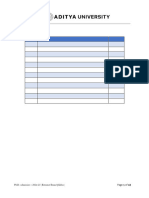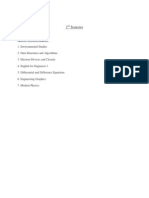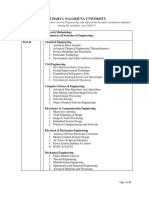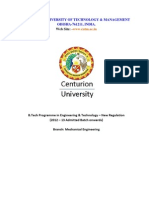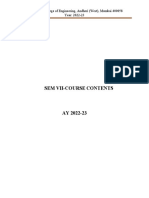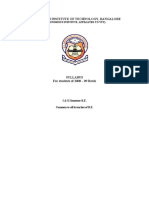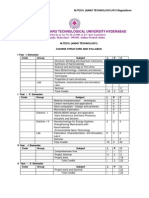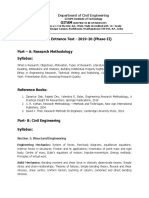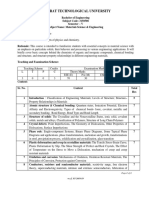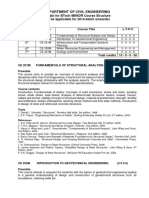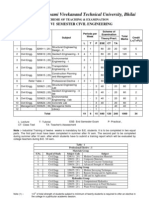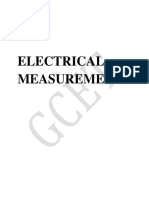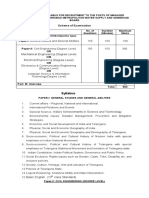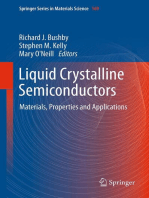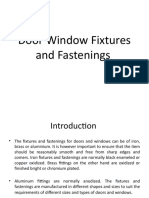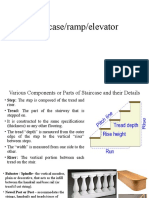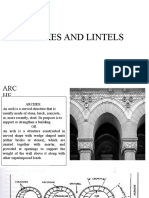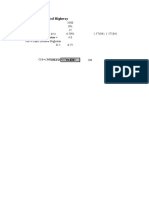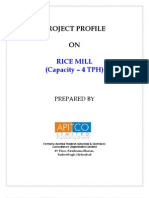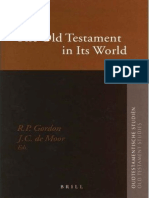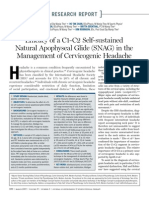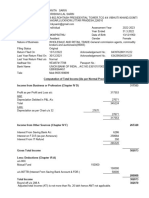SGU PHD Test
SGU PHD Test
Uploaded by
Sushant WaghmareCopyright:
Available Formats
SGU PHD Test
SGU PHD Test
Uploaded by
Sushant WaghmareOriginal Description:
Original Title
Copyright
Available Formats
Share this document
Did you find this document useful?
Is this content inappropriate?
Copyright:
Available Formats
SGU PHD Test
SGU PHD Test
Uploaded by
Sushant WaghmareCopyright:
Available Formats
Ph.D.
Entrance Test Syllabus (SGUPET-2019) 2019-20
Sanjay Ghodawat University Kolhapur
Maharashtra, India
Ph.D. Entrance Test (SGU-PET) Syllabus
Sanjay Ghodawat University Kolhapur
Kolhapur - Sangli Highway, Atigre, Dist: Kolhapur (MH) - 416118
Contact: +91 90110 39800, 90110 22567, 98222 55410
email: registrar@sanjayghodawatuniversity.ac.in
website: www.sanjayghodawatuniversity.ac.in
Sanjay Ghodawat University Kolhapur Page 1
Ph.D. Entrance Test Syllabus (SGUPET-2019) 2019-20
Ph.D. Entrance Test (SGUPET-2019) 2019-20 Syllabus
Section – I: Research Methodology (50% Weightage)
(Common to All)
Chapter Content
Chapter 1 Fundamentals of Research, Aims and objectives of research, Types of research
– basic, novel and applied research. Tools for searching research topic – books,
journals, internet, discussions etc. Research hypothesis, Steps in research
design, Research process, Litrature review
Chapter 2 Research Aptitude Qualities of a researcher, Logical reasoning, Test for
intelligence, Basic mathematics. Ethics in research – plagiarism
Chapter 3 Research methods a) Formulating a research problem, features of good
research designs, scientific, developing a research plan b) Methods:
Experiments, surveys, Questionnaires, Interviews, Telephone Surveys, mail
surveys, Case Studies, Participant and non participant observation,
observational trials c) Sampling design: Census and sample surveys, implication
of sample design, types of sample design d) Method of sample collection:
Collection of primary data, Collection of Secondary data, Sampling distribution,
Validation of data e) Processing and analysis of data: Statistics in research,
Measures of central tendency, measures of dispersion, measures of
asymmetry, Simple regression analysis, use of computers in research,
Hypothesis testing, Chi-square test, Students ‘t test, ANOVA test f)
Interpretation and report writing: preparation of tables and graphs,
Observation writing and its interpretation, Report format
Chapter 4 Research methods a) Laboratory experiments, field trials, use of instruments,
observations b) Interviews, Questionnaire surveys, Telephone survey, mail
Survey, Postal survey, and checklists. Design of experiments.
Chapter 5 Report writing, contents of research report, Intellectual property rights and
patenting. Patent registration, patent search, process of patenting.
References: 1. Research Methodology: The aims, Practices and ethics of science By
Peter Pruzan- Springer
2. Principles and Techniques of Biochemistry and molecular Biology by
Keith Wilson and John Wolker
3. Research Methodology methods and Techniques (second revised
edition) by C. R. Kothari, New Age Publishers.
Sanjay Ghodawat University Kolhapur Page 2
Ph.D. Entrance Test Syllabus (SGUPET-2019) 2019-20
Ph.D. Entrance Test (SGUPET-2019) 2019-20 Syllabus
Section – II: Civil Engineering (Weightage 50%) (Subject Specific)
Chapter Content
Chapter 1 Strength of materials
Introduction, Properties of Materials, Stress, Strain, Hooke’s law, Poisson’s
Ratio, Stress–Strain Diagram for structural steel and non ferrous materials,
Principle of superposition, Total elongation of tapering bars of circular and
rectangular cross sections, volumetric strain, expression for volumetric strain,
Elastic constants, Relationships among elastic constants, Stresses in composite
bars, Thermal stresses in simple and compound bars. Types of beams, loadings
and supports, Shearing force, bending moment
Chapter 2 Fluid mechanics
Definition of Fluid, Systems of units, properties of fluid: Mass density, Specific
weight, Specific gravity, Specific volume, Viscosity, Cohesion, Adhesion, Surface
tension, & capillarity. Newton’s law of viscosity. Capillary rise in a vertical tube
and between two plane surfaces Definition of pressure, Pressure at a point,
Pascal’s law, Variation of pressure with depth. Types of pressure. Vapor
pressure. Measurement of pressure using simple, differential & inclined
manometers. Introduction to Mechanical and electronic pressure measuring
devices.
Chapter 3 Environmental Engineering
Systems of water supply, Objectives of water quality management, Water
quality parameters – Physical, chemical and Microbiological, Sampling, Water
quality analysis (IS: 3025 and IS: 1622), Drinking water standards BIS & WHO
guidelines. Health significance of Fluoride, Nitrates and heavy metals like
Mercury, Cadmium, Arsenic etc and toxic / trace organics, water borne
diseases, Objectives of Water Treatment, Flow chart of treatment units,
Aeration Principles, types; Sedimentation- theory, types
Chapter 4 Geotechnical Engineering
Formation of soil – types of soil – clay mineralogy and soil structure: Soil-Water
system, Electrical diffuse double layer, adsorbed water, base-exchange
capacity, Common clay minerals in soil and their structures- Index Properties-
Three phase system of soil and their relationships – Grain size analysis –
Stoke’s law and hydrometer analysis – Consistency of soils –Determination of
consistency indices – Classification of coarse grained and fine grained soil as
per BIS
Chapter 5 Transportation Engineering
Importance of transportation, comparison of various modes of transportation,
importance and scope of highway engineering, highway planning and
alignment, importance of highway geometric design and scope of traffic
engineering, principles of urban transportation, mass transit facilities,
Sanjay Ghodawat University Kolhapur Page 3
Ph.D. Entrance Test Syllabus (SGUPET-2019) 2019-20
integration of different modes of transportation
Chapter 6 Project Management
Optimization Techniques, Concrete Technology, Construction Materials, Linear
and non linear programming Techniques, Legal Aspects in Construction
Industry. Project planning and Control, Project cost control
References: 1. R.C. Hibbeler, Mechanics of Materials, 8thEdition, Prentice Hall, 2011
2. P. N. Modi and S. M. Seth, Hydraulics and Fluid Mechanics, :Standard Book
House, 2010.
3. Geotechnical Earthquake Engineering, S. L. Kramer, Pearson
Publication.
4. Hira Gupta, Operations Research, S. Chand Publications, 2010.
5. S. K. Garg, Water Supply Engineering, Khanna Publications, 2010
6. B. C. Punmia, Waste Water Engineering, Laxmi Publications, 2011.
7. S.Timoshenko, Strength of Materials,Part –I,
D.VanNostrandCompany,Newyork.
8. Chitkara K.K., Construction Project Management, Tata Mcgraw Hill
Education Pvt. Ltd.
9. Kadiyali L.R., Transportation Engineering, Khanna Publishing Co.
Ph.D. Entrance Test (SGUPET-2019) 2019-20 Syllabus
Section – II: Electronics Engineering (Weightage 50%)(Subject Specific)
Chapter Content
Chapter 1 Networks
Network graphs: matrices associated with graphs; incidence, fundamental cut
set and fundamental circuit matrices. Solution methods: nodal and mesh
analysis. Network theorems: superposition, Thevenin and Norton’s maximum
power transfer, Wye-Delta transformation. Steady state sinusoidal analysis
using phasors. Linear constant coefficient differential equations; time domain
analysis of simple RLC circuits, Solution of network equations using Laplace
transform: frequency domain analysis of RLC circuits. 2-port network
parameters: driving point and transfer functions. State equations for networks
Chapter 2 Electronic Devices
Energy bands in silicon, intrinsic and extrinsic silicon. Carrier transport in
silicon: diffusion current, drift current, mobility, and resistivity. Generation and
recombination of carriers. p-n junction diode, Zener diode, tunnel diode, BJT,
JFET, MOS capacitor, MOSFET, LED, p-I-n and avalanche photo diode, Basics of
LASERs. Device technology: integrated circuits fabrication process, oxidation,
diffusion, ion implantation, photolithography, n-tub, p-tub and twin-tub CMOS
process
Sanjay Ghodawat University Kolhapur Page 4
Ph.D. Entrance Test Syllabus (SGUPET-2019) 2019-20
Chapter 3 Analog Circuits
Small Signal Equivalent circuits of diodes, BJTs, MOSFETs and analog CMOS.
Simple diode circuits, clipping, clamping, rectifier. Biasing and bias stability of
transistor and FET amplifiers. Amplifiers: single-and multi-stage, differential
and operational, feedback, and power. Frequency response of amplifiers.
Simple op-amp circuits. Filters. Sinusoidal oscillators; criterion for oscillation;
single transistor and op-amp configurations. Function generators and wave-
shaping circuits, 555 Timers. Power supplies.
Chapter 4 Digital Circuits and Microprocessors
Boolean algebra, minimization of Boolean functions; logic gates; digital IC
families (DTL, TTL, ECL, MOS, CMOS). Combinatorial circuits: arithmetic circuits,
code converters, multiplexers, decoders, PROMs and PLAs. Sequential circuits:
latches and flip-flops, counters and shift registers. Sample and hold circuits,
ADCs, DACs. Semiconductor memories. Microprocessor(8085): architecture,
programming, memory and I/O interfacing.
Chapter 5 Signals & Systems
Definitions and properties of Laplace transform, continuous-time and discrete
time Fourier series, continuous-time and discrete-time Fourier Transform, DFT
and FFT, z-transform. Sampling theorem, Linear Time-Invariant (LTI) Systems:
definitions and properties; causality, stability impulse response, convolution,
poles and zeros, parallel and cascade structure, frequency response, group
delay, phase delay. Signal transmission through LTI systems
Chapter 6 Digital Signal Processing
Review of discrete time signals and systems, system properties, discrete LTI
system, impulse response, convolution, system representation by difference
equation, natural and forced responses, Review of Fourier transform, DTFT,
DTFS and Z-transform, DFT and circular convolution, Basic concepts of IIR and
FIR filters
Chapter 7 Electromagnetics
Elements of vector calculus: divergence and curl; Gauss’s and stoke’s
theorems, Maxwell’s equations: differential and integral forms. Wave
equation, pointing vector. Plane waves: propagation through various media;
reflection and refraction; phase and group velocity; skin depth. Transmission
lines: characteristic impedance; impedance transformation; Smith chart;
Impedance matching; Sparameters, pulse excitation. Waveguides: modes in
rectangular waveguides; boundary conditions; cut-off frequencies; dispersion
relations. Basics of propagation in dielectric waveguide and optical fibers.
Sanjay Ghodawat University Kolhapur Page 5
Ph.D. Entrance Test Syllabus (SGUPET-2019) 2019-20
Basics of Antennas: Dipole antennas; radiation pattern; antenna gain.
Chapter 8 Digital Communication
Sampling theorem, quantization, quantization noise and signal to noise ratio
analysis in PCM, DPCM and DM, Baseband transmission, intersymbol
interference, Nyquist criterion for zero ISI, wave shaping and correlative
coding, Linear equalization, decision feedback equalization, maximum
likelihood sequence estimation, Digital modulation techniques-BPSK, FSK,
QPSK, MSK, matched filter receiver and probability of error analysis in BPSK,
FSK and QPSK.
Chapter 9 Control Systems
Basic control system components; block diagrammatic description, reduction
of block diagrams. Open loop and closed loop (feedback) systems and stability
analysis of these systems. Signal flow graphs and their use in determining
transfer functions of systems; transient and steady state analysis of LTI control
systems and frequency response. Tools and techniques for LTI control system
analysis: root loci, Routh-Hurwitz criterion, Bode and Nyquist plots. Control
system compensators: elements of lead and lag compensation, elements of
Proportional- Integral Derivative (PID) control. State variable representation
and solution of state equation of LTI control systems.
References: 1. Network Analysis & Synthesis, Ghosh, 1E, TMH, 2010.
2. Networks and Systems, D Roy Choudhury, New Age Publication, 2008.
3. Millman's Electronic Devices & Circuits, SIE 4th Edition, Millman&Halkias,
McGraw-Hill Education,2015
4. Semiconductor Physics And Devices by Donald A. Neamen
5. Elements of Electromagnetics by Matthew N.O. Sadiku,
6. Electromagnetic waves and Radiating Systems by Jordon and ballmain,
Antenna Theory by Balanis
7. Digital Logic and Computer Design by M.Morris Mano
8. Analog and Digital Communication System by Simon Haykin
9. Principle of Communication System by Taub& Schillings
10. Modern digital and analog Communications system by BP Lathi
11. Analog Electronics, Electronics devices and circuits – Donald A Neaman,
12. Microelectronics Circuits by Sedra& Smith
13. Electronic Devices and Circuit Theory by Robert L Boylestad&Nashelsky
14. Control Systems Engineering by NormamNise
15. Control Systems by Nagarath and Gopal
16. Signals & Systems By Alan V. Oppenheim
Sanjay Ghodawat University Kolhapur Page 6
Ph.D. Entrance Test Syllabus (SGUPET-2019) 2019-20
17. Digital Signal Processing by S.K Mitra
Ph.D. Entrance Test (SGUPET-2019) 2019-20 Syllabus
Section – II: Mechanical Engineering (50% Weightage)(Subject
Specific)
Chapter Content
Chapter 1 Strength of Materials
Stress and strain, stress-strain relationship and elastic constants, Mohr's circle
for plane stress and plane strain, thin cylinders; shear force and bending
moment diagrams; bending and shear stresses; deflection of beams; torsion of
circular shafts; Euler's theory of columns; strain energy methods; thermal
stresses.
Chapter 2 Theory of Machines
Displacement, velocity and acceleration analysis of plane mechanisms;
dynamic analysis of slider-crank mechanism; gear trains; flywheels.
Vibrations: Free and forced vibration of single degree of freedom systems;
effect of damping; vibration isolation; resonance, critical speeds of shafts
Chapter 3 Design
Design for static and dynamic loading; failure theories; fatigue strength and the
S-N diagram; principles of the design of machine elements such as bolted,
riveted and welded joints, shafts, spur gears, rolling and sliding contact
bearings, brakes and clutches.
Chapter 4 Fluid Mechanics
Fluid properties; fluid statics, manometer , buoyancy; control-volume analysis
of mass, momentum and energy; fluid acceleration; differential equations of
continuity and momentum; Bernoulli's equation; viscous flow of
incompressible fluids; boundary layer; elementary turbulent flow; flow through
pipes, head losses in pipes, bends etc.
Chapter 5 Thermodynamics
Zeroth, First and Second laws of thermodynamics; thermodynamic system and
processes; Carnot cycle. Irreversibility and availability; behavior of ideal and
real gases, properties of pure substances, calculation of work and heat in ideal
processes; analysis of thermodynamic cycles related to energy conversion. I.C.
Engines: air-standard Otto, Diesel cycles. Refrigeration and air-conditioning:
Vapour refrigeration cycle, heat pumps, gas refrigeration, Reverse Brayton
cycle; moist air: psychrometric chart, basic psychrometric processes.
Chapter 6 Materials
Sanjay Ghodawat University Kolhapur Page 7
Ph.D. Entrance Test Syllabus (SGUPET-2019) 2019-20
Structure and properties of engineering materials, heat treatment, stress-strain
diagrams for engineering materials.
Chapter 7 Metal Casting: Design of patterns, moulds and cores; solidification and cooling;
riser and gating design, design considerations.
Forming: Plastic deformation and yield criteria; fundamentals of hot and cold
working processes; load estimation for bulk (forging, rolling, extrusion, and
drawing) and sheet (shearing, deep drawing, and bending) metal forming
processes; principles of powder metallurgy.
Joining: Physics of welding, brazing and soldering; adhesive bonding; design
considerations in welding.
Chapter 8 Machining and Machine Tool Operations
Mechanics of machining, single and multi-point cutting tools, tool geometry
and materials, tool life and wear; economics of machining; principles of non-
traditional machining processes; principles of work holding, principles of design
of jigs and fixtures.
Chapter 9 Metrology and Inspection
Limits, fits and tolerances; linear and angular measurements; comparators;
gauge design; interferometry; form and finish measurement; alignment and
testing methods; tolerance analysis in manufacturing and assembly.
Chapter 10 Industrial Engineering: Work Study and Method study, Micromotion study and
Time study. Productivity Measurement. Ergonomics Anthropometry Work
station Design, Job evaluation and Merit Rating.
References: 1. R.C. Hibbeler, Mechanics of Materials, 8thEdition, Prentice Hall, 2011
2. M. F. Spott, Design of Machine Elements, Prantice Hall Inc.
3. W T Thomson, Theory of Vibration and Application,CBS Publishers and
Distributors Pvt. Ltd
4. Dr.R.K. Bansal: Fluid Mechanics and Hydraulic Machines, 9thEdn, Laxmi
Publications, 2010.
5. Cenegal Y. A. and Boles M. A, Thermodynamics an Engineering
approach, Tata McGraw, 2011
6. P.N Rao, Manufacturing Technology, Volume I & II, Tata Mc Graw Hill
7. H. S. Shan, Manufacturing Processes: Casting, Forming and Welding
8. ILO, Introduction to Work Study Oxford & IBH Publishing Co., New Delhi
(2006)
9. William F. Smith, JavadHashemi, Material Science and Engineering (In Si
Units),
10. Raghavendra N. V.Engineering Metrology and Measurements
11. R. S. Khurmi, Theory of Machines, S Chand Publication
Sanjay Ghodawat University Kolhapur Page 8
Ph.D. Entrance Test Syllabus (SGUPET-2019) 2019-20
Ph.D. Entrance Test (SGUPET-2019) 2019-20 Syllabus
Section – II: Computer Science and Engineering (50% weightage)
(Subject Specific)
Chapter Content
Chapter 1 Digital Logic Boolean algebra. Combinational and sequential circuits.
Minimization. Number representations and computer arithmetic (fixed and
floating point).
Chapter 2 Computer Organization and Architecture Machine instructions and addressing
modes. ALU, data‐path and control unit. Instruction pipelining. Memory
hierarchy: cache, main memory and secondary storage; I/O interface (interrupt
and DMA mode).
Chapter 3 Programming and Data Structures Programming in C. Recursion. Arrays, stacks,
queues, linked lists, trees, binary search trees, binary heaps, graphs
Chapter 4 Algorithms Searching, sorting, hashing. Asymptotic worst case time and space
complexity. Algorithm design techniques: greedy, dynamic programming and
divide-and‐conquer. Graph search, minimum spanning trees, shortest paths.
Chapter 5 Theory of Computation Regular expressions and finite automata. Context-free
grammars and push-down automata. Regular and context-free languages,
pumping lemma. Turing machines and undecidability.
Chapter 6 Compiler Design Lexical analysis, parsing, syntax-directed translation. Runtime
environments. Intermediate code generation.
Chapter 7 Operating System Processes, threads, inter-process communication,
concurrency and synchronization. Deadlock. CPU scheduling. Memory
management and virtual memory. File systems. Section 8: Databases
ER‐model. Relational model: relational algebra, tuple calculus, SQL. Integrity
constraints, normal forms. File organization, indexing (e.g., B and B+ trees).
Transactions and concurrency control.
Chapter 8 Computer Networks Concept of layering. LAN technologies (Ethernet). Flow
and error control techniques, switching. IPv4/IPv6, routers and routing
algorithms (distance vector, link state). TCP/UDP and sockets, congestion
control. Application layer protocols (DNS, SMTP, POP, FTP, HTTP). Basics of Wi-
Fi. Network security: authentication, basics of public key and private key
cryptography, digital signatures and certificates, firewalls.
References: 1. Algorithms: Introduction to Algorithms by Rivest, Cormen, Stein,
Leiserson, MIT Press Operating System: "Operating System Concepts”
by Galvin, Silberschatz. WILEY Publishers
2. Theory of Computation: "Introduction to Automata Theory, Languages
and Computation" by Hopcroft, Ullman. Pearson Education
Sanjay Ghodawat University Kolhapur Page 9
Ph.D. Entrance Test Syllabus (SGUPET-2019) 2019-20
3. Computer Networks: "Computer Networking: A top-down approach" by
Kurose-Ross. Pearson Education
4. "Computer Networks" by Tanenbaum, Prentice Hall
5. Computer Organisation: "Computer Organisation" by Carl Hamacher.
McGraw Hill Programming:
6. “Computer Systems: A Programmer’s Perspective”, Randal E. Prentice
Hall “Java: The Complete Reference, 8th Edition”, Herbert Schildt.
McGraw Hill
7. Database Systems: "Database System Concepts" by Korth. McGraw Hill
8. Compiler Design: "Principles of Compiler Design" by Aho and Ullman.
Narosa Publishing House
9. Digital Logic: "Digital Logic and Design" by Morris Mano. Pearson
Education, Prentice Hall
10. Software Engineering: "Software Engineering: A Practitioner's
Approach" by Pressman. Prentice
Ph.D. Entrance Test (SGUPET-2019) 2019-20 Syllabus
Section – II: Electrical Engineering (50% weightage)
(Subject Specific)
Chapter Content
Chapter 1 Power Electronics: Power Semiconductor devices and characteristics, Single
Phase and Three Phase AC-DC Converters and applications, Operation of buck,
boost and buck boost converters, operation of inverters – 180 degree mode,
Sinusoidal PWM Technique, Application of Power Electronics converters in
Renewable Energy Sources.
Chapter 2 Electrical Machines: DC Machine – Separately Excited, Series, Shunt and
Compound Machine, Theory and operation of single and three phase
transformers, Induction machines – squirrel cage and wound rotor, Salient Pole
and Non- Salient Pole Synchronous Machine, Methods of speed control of dc
and induction machines, Operation and Application of Permanent Magnet
Synchronous Machine, Brush Less DC Machine.
Chapter 3 Power Systems: Transmission lines, Series and shunt compensation, Per‐unit
quantities, Bus admittance matrix, Gauss-Seidel and Newton-Raphson load
flow methods, Voltage and Frequency control, Power factor correction,
Symmetrical components, Symmetrical and unsymmetrical fault analysis,
Principles of over‐current, differential and distance protection; Circuit
breakers, System stability concepts, Equal area criterion. Power Quality issues
in Power System and Grid
Sanjay Ghodawat University Kolhapur Page 10
Ph.D. Entrance Test Syllabus (SGUPET-2019) 2019-20
Chapter 4 Control Systems: Transfer function of a dynamic system, positive and negative
feedback, transient and steady state response, Routh-Hurwitz and Nyquist
criteria, Bode plots, Root loci, Stability analysis, lead, lag and lead-lag
compensation, P, PI and PID controllers, State space model, State transition
matrix, eigen values.
References: 1. I.J. Nagrath and M. Gopal, “Control System Engineering”, New age
international (P) Ltd, 5th edition, 2014.
2. Nagarath& Kothari “Electrical Machines”, TMH Publications, 5th
Edition.
3. Bimbhra, P.S., “Electrical Machinery”, Khanna Publishers 7th Edition
4. Rashid Muhammad, H., “Power Electronics: Circuits, Devices and
Applications”, 2nd Edition, Prentice-Hall, 1998.
5. Allen. J. Wood and Bruce F. Wollenberg, “Power Generation, Operation
and Control”, John Wiley & Sons, Inc., 2003.
6. AbhijitChakrabarti,SunitaHalder, “Power System Analysis Operation and
Control”, PHI learning Pvt. Ltd., New Delhi, Third Edition, 2010.
Ph.D. Entrance Test (SGUPET-2019) 2019-20 Syllabus
Section – II: Management (50% Weightage)(Subject Specific)
Chapter Content
Chapter 1 Introduction to Business Administration
Managerial Economics -Demand analysis-Production Functions-Cost-output
relations - Market Structures-Pricing theories-Advertising-Macro-economics
National Income Concepts-Infrastructure-management and Policy-Business
Environment-Capital Budgeting.
Chapter 2 Theories & Schools of Thoughts
The concept and significance of organizational behavior-skills & roles in an
organization-classical, Neo-classical and modern theories of organizational
structure-Organizational design-Understanding and managing individual
behaviour,Personality-Perception-Values-Attitudes-Learning-Motivaiton.
Understanding & managing group behavior, Process-Inter- personal & group
dynamics-Communication-Leadership-Managing Change-Managing Conflicts.
Chapter 3 Human Resource Management
Concepts & perspectives in HRM: HRM in changing environment, Human
resource planning-Objectives, Process &Techniques-Job analysis- job
description- Selecting Human Resources-Induction, Training & Development-
Exit policy & Implications-Performance Appraisal & Evaluation-Potential
Assessment-Job Evaluation-Wage Determination-Industrial Relations & Trade
Unions-Dispute Resolutions & Grievance Management – Labour Welfare &
Sanjay Ghodawat University Kolhapur Page 11
Ph.D. Entrance Test Syllabus (SGUPET-2019) 2019-20
Social Security Measures.
Chapter 4 Financial Management
Financial management-Nature & scope – Valuation concepts & Valuation of
securities – Capital budgeting decisions – Risk analysis – Capital structure &
cost of Capital – Dividend policy – Determinants – long- term & short term
financing instruments – Mergers & Acquisitions.
Chapter 5 Marketing Management
Marketing Environment & Environment scanning: Marketing Information
systems & Marketing Research: Understanding Consumer & Industrial markets:
Demand Measurement & Forecasting: Market segmentation – Targeting &
positioning: Product decisions, Product mix, Product life cycle: New product
development: Branding & packaging: Pricing methods & strategies. Promotion
decisions – Promotion mix: Advertising: Personal selling: Channel
management: Vertical marketing systems: Evaluation & control of marketing
effort: Marketing of services: Customer relation management:
Uses of internet as a marketing medium – other related issues like branding,
market development, Advertising & Retailing on the net. New issues in
Marketing, Advertisement, Social Media.
Chapter 6 Production Management
Role & scope of production management: Facility location: Layout planning &
analysis: Production planning & control – Production process analysis: Demand
forecasting for Operations; Determinants of product mix: Production
scheduling: Work measurement: Time & Motion study: Statistical Quality
Control. Role & scope of Operations Research: Linear programming: Sensitivity
analysis: Duality: Transportation model: Inventory control: Queuing theory:
Decision theory: Markov analysis PERT/CPM.
Chapter 7 Operation Research
Probability theory: Probability distributions – Binomial, Poisson, Normal &
Exponential; Correlation & regression analysis; Sampling theory; sampling
distributions; Tests of Hypothesis; large & small samples; t, z, f, Chi-square
tests.
Chapter 8 IT and Systems
Use of Computers in Managerial applications; Technology issues and Data
processing in organization; Information Systems; MIS & Decision making;
System analysis & design; Trends in Information Technology; Internet &
Internet based applications.
Chapter 9 Strategic Management
Concept of corporate strategy; Components of strategy formulations; Ansoff’s
growth vector; BCG Model; Porter generic strategies; Competitor analysis;
Strategic dimensions and group mapping: Industry analysis; Strategy in
Industry evolution, fragmentation, maturity and decline; Competitive Strategy
& Corporate Strategy; Trans nationalization of world economy; Managing
cultural diversity; Global entry strategies; Globalization of financial system &
Sanjay Ghodawat University Kolhapur Page 12
Ph.D. Entrance Test Syllabus (SGUPET-2019) 2019-20
services; Managing International business; Competitive advantage of national;
RTP & WTO.
Chapter 10 International Business
India’s Foreign Trade & policy; Export Promotion policies; Trade agreements
with other countries; Policy & performance of export Zones & Export Oriented
Units; Exports incentives. International marketing logistics; International
logistical structures; Export Documentation frame-work; Organization of
shipping services; Chartering practices; Marine cargo insurance.
International financial environment; Foreign exchange markets; Determination
of exchange rates; Exchange risk measurement; International investment;
International capital markets; International Credit Rating agencies &
Implication of their ratings.
WTO & Multilateral trade agreements pertaining to trade in goods: Trade in
services & TRIPS; Multilateral Environmental Agreements (MEAs); International
Trade Blocks- NAFTA, ASEAN, SAARC, EU, WTO & Dispute settlement
Mechanism.
Technology monitoring; Emerging opportunities for global business.
References: 1. Managerial Economics –D M Mithani, 5/e, Himalaya Publication. 2011.
2. Managerial Economics – D N Dwivedi, 7/e, Vikas Publication. 2008
3. Essentials of Management-Koontz, 8/e, McGraw Hill
4. Fred Luthans - ‘Organisational Behavior’, McGraw Hill Publishing
Company, New York, 2011.
5. Human Resource Management by Gary Dessler
6. Financial Management - Khan M. Y.& Jain P. K, 6/e, TMH, 2011.
7. Financial Management - Prasanna Chandra, 8/e, TMH, 2011.
8. Marketing Management: A South Asian Perspective – Philip Kotler,
Kevin Lane Keller, Abraham Koshy, MithileshwarJha, 14/e, Pearson
9. Production and Operations Management: Prof. K. Ashwathappa, K
Sridhar Bhat, Himalaya Publications
10. Strategic Management: An Integrated Approach - Charles W. L. Hill,
Gareth R. Jones, Cengage Learning.
11. Business Policy and Strategic Management – SubbaRao P, HPH.
12. Aswathappa, INTERNATIONAL BUSINESS, Tata Mc Graw Hill
publications, New Delhi
13. Operations Research: An Introduction by HamdyTaha, Pearson
14. Operations Research by H N Wagner, Prentice hall.
15. Optimization in Operations Research by Ronald Rardin, Pearson
Education Inc.
16. Operations Research by R. Paneerselvam, Prentice Hall of India Pvt. Ltd.
17. Quantitative Techniques in Management by N D Vohra, McGraw-Hill
18. Information Technology Management By Raner ,Potter and Turban.
19. IT for Management- Making connections for strategic advantage-
Turban, McLean and Wetherbe
Sanjay Ghodawat University Kolhapur Page 13
Ph.D. Entrance Test Syllabus (SGUPET-2019) 2019-20
Ph.D. Entrance Test (SGUPET-2019) 2019-20 Syllabus
Section – II: PHYSICS (School of Science) (50% Weightage)(Subject
Specific)
Chapter Content
Chapter 1 Mathematical Methods of Physics
Vector algebra and vector calculus; Linear algebra, matrices, Cayley Hamilton
theorem, eigenvalue problems; Linear differential equations; Special functions
(Hermite, Bessel, Laguerre and Legendre); Fourier series, Fouriertransform and
Laplace transform; Elements of complex analysis: Laurent series-poles,
residues and evaluation of integrals; Elementary ideas about tensors; group
theory numerical methods, probability.
Chapter 2 Classical Mechanics
Newton’s laws; Phase space dynamics, stability analysis; Central-force motion;
Two-body collisions, scattering; Rigid body dynamics, non-inertial frames
Variational principle, Lagrangian and Hamiltonian formalisms and equations of
motion; Poisson brackets and canonical transformations; cyclic coordinates;
Periodic motion, small oscillations and normal modes; Special theory of
relativity, Lorentz transformations, relativistic kinematics and mass–energy
equivalence.
Chapter 3 Electromagnetic Theory
Electrostatics: Gauss’ Law and its applications; Laplace and Poisson equations,
boundary value problems; Magnetostatics: Biot-Savart law, Ampere's theorem,
electromagnetic induction; Maxwell's equations in free space and linear
isotropic media; Scalar and vector potentials; Gauge invariance;
Electromagnetic waves in free space, dielectrics, and conductors; Reflection
and refraction, polarization, Fresnel’s Law, interference, coherence, and
diffraction; Dispersion relations in plasma; Lorentz invariance of Maxwell’s
equations; Transmission lines and wave guides; Dynamics of charged particles
in static and uniform electromagnetic fields; Radiation from moving charges,
dipoles and retarded potentials.
Chapter 4 Quantum Mechanics
Wave-particle duality; Commutators and Heisenberg's uncertainty principle;
Matrix representation; Dirac’s bra and ket notation; Schroedinger equation
(time-dependent and time-independent); Eigenvalue problems such as
particle-in-a-box, harmonic oscillator, etc.; Tunneling through a barrier; Motion
in a central potential; Orbital angular momentum, Angular momentum algebra,
spin; Addition of angular momenta; Hydrogen atom, spin-orbit coupling, fine
structure; Time-independent perturbation theory and applications; Variational
method; WKB approximation;Time dependent perturbation theory and Fermi's
Golden Rule; Selection rules; Semi-classical theory of radiation; Elementary
Sanjay Ghodawat University Kolhapur Page 14
Ph.D. Entrance Test Syllabus (SGUPET-2019) 2019-20
theory of scattering, phase shifts, partial waves, Born approximation; Identical
particles, Pauli's exclusion principle, spin-statistics connection; Relativistic
quantum mechanics: Klein Gordon and Dirac equations.
Chapter 5 Thermodynamic and Statistical Physics
Laws of thermodynamics and their consequences; Thermodynamic potentials,
Maxwell relations; Chemical potential, phase equilibria; Phase space, micro-
and macrostates; Microcanonical, canonical and grand-canonical ensembles
and partition functions; Free Energy and connection with thermodynamic
quantities; First- and second-order phase transitions; Classical and quantum
statistics, ideal Fermi and Bose gases; Principle of detailed balance; Blackbody
radiation and Planck's distribution law; Bose-Einstein condensation.
Chapter 6 Electronics
Semiconductor device physics, including diodes, junctions, transistors, field
effect devices, homo and heterojunction devices, device structure, device
characteristics, frequency dependence and applications; Optoelectronic
devices, including solar cells, photodetectors, and LEDs; High-frequency
devices, including generators and detectors; Operational amplifiers and their
applications; Digital techniques and applications (registers, counters,
comparators and similar circuits); A/D and D/A converters; Microprocessor and
microcontroller basics.
Chapter 7 Experimental Techniques and data analysis
Data interpretation and analysis; Precision and accuracy, error analysis,
propagation of errors, least squares fitting, linear and nonlinear curve fitting,
chi-square test; Transducers (temperature, pressure/vacuum, magnetic field,
vibration, optical, and particle detectors), measurement and control; Signal
conditioning and recovery, impedance matching, amplification (Op-amp based,
instrumentation amp, feedback), filtering and noise reduction, shielding and
grounding; Fourier transforms; lock-in detector, box-car integrator, modulation
techniques.
Chapter 8 Atomic & Molecular Physics
Quantum states of an electron in an atom; Electron spin; Stern-Gerlach
experiment; Spectrum of Hydrogen, helium and alkali atoms; Relativistic
corrections for energy levels of hydrogen; Hyperfine structure and isotopic
shift; width of spectral lines; LS & JJ coupling; Zeeman, Paschen Back & Stark
effect; X-ray spectroscopy; Electron spin resonance, Nuclear magnetic
resonance, chemical shift; Rotational, vibrational, electronic, and Raman
spectra of diatomic molecules; Frank – Condon principle and selection rules;
Spontaneous and stimulated emission, Einstein A & B coefficients, lasers.
Chapter 9 Condensed Matter Physics
Bravais lattices; Reciprocal lattice, diffraction and the structure factor; Bonding
of solids; Elastic properties, phonons, lattice specific heat; Free electron theory
and electronic specific heat; Response and relaxation phenomena; Drude
model of electrical and thermalconductivity; Hall effect and thermoelectric
Sanjay Ghodawat University Kolhapur Page 15
Ph.D. Entrance Test Syllabus (SGUPET-2019) 2019-20
power; Diamagnetism, paramagnetism, and ferromagnetism; Electron motion
in a periodic potential, band theory of metals, insulators and semiconductors;
Superconductivity, type–I and type-II uperconductors, Josephson junctions;
Defects and dislocations; Ordered phases of matter, translational and
orientational order, kinds of liquid crystalline order; Conducting polymers;
Quasicrystals.
Chapter 10 Nuclear and Particle Physics
Basic nuclear properties: size, shape, charge distribution, spin and parity;
Binding energy, semi-empirical mass formula; Liquid drop model; Fission and
fusion; Nature of the nuclear force, form of nucleon-nucleon potential; Isospin;
Deuteron problem; Evidence of shell structure, single- particle shell model,
Rotational spectra; Elementary ideas of alpha, beta and gamma decays and
their selection rules; Nuclear reactions, reaction mechanisms, compound
nuclei and direct reactions; Classification of fundamental forces; Elementary
particles (quarks, baryons, mesons, leptons); Spin and parity assignments,
isospin, strangeness; Gell-Mann-Nishijima formula; C, P, and T invariance and
applications of symmetry arguments to particle reactions, parity non-
conservation in weak interaction; Relativistic kinematics.
References: Mathematical Method of Physics
1. Mathematical Methods For Physicists, 6th Edition, by Arfken And Weber
(Academic Press, 2005).
2. Mathematical Methods for Physics and Engineering, 3rd edition, by Riley
K F, Hobson M P and Bence S J, (Cambridge University Press, 2006)
3. Advanced Engineering Mathematics, 10th Edition, byErwinKreyszig,
(Wiley & Sons, 2010).
4. Mathematical Physics, RevisedEdition, by H.K. Dass, (S. Chand, 2008).
Classical Mechanics
1. Classical Mechanics, by H Goldstein (Addison Wesley 1980).
2. Classical Mechanics, by N C Rana and P S Joag (Tata McGraw Hill 1991).
3. Introduction to Classical Mechanics, by R G Takwale and P S Puranik
(Tata McGraw Hill 1999).
4. Classical Mechanics, by Gupta, Kumar and Sharma (PragatiPrakashan
2000).
Electromagnetic Theory
1. Introduction to Electrodynamics, 4th Edition by David J. Griffiths
(Pearson Education, 2014).
2. Foundation of Electrodynamics Theory, 3rd Edition by J.R. Reitz, F.J.
Milford and R.W. Christy (Narosa Publication House 1993)
3. Classical Electrodynamics, 2nd Edition by J.D.Jackson (Wiley Eastern)
4. Classical Electrodynamics by S.P. Puri (Tata McGraw Hill, 1990)
Quantum Mechanics
1. Introduction to Quantum Mechanics, 2nd Edition, by David J. Griffiths
(Pearson, 2014)
Sanjay Ghodawat University Kolhapur Page 16
Ph.D. Entrance Test Syllabus (SGUPET-2019) 2019-20
2. Introductory Quantum Mechanics, 4th Edition, by Li boff, (Pearson
Education Ltd.).
3. Quantum Mechanics: Concepts and Applications, illustrated, by
NouredineZettili (Wiley and Sons, 2009)
4. Quantum Physics, 2nd Edition by H. C. Verma(Surya Publications, 2009).
Thermodynamics and Statistical Physics
1. Statistical and Thermal Physics An Introduction, by S.
Loknathan&Gambhir (PHI Learning Pvt. Ltd., 2008)
2. Statistical mechanics, 3rd edition, by R. K. Pathria, (Butterworth-
Heinemann publications, 2011).
3. Statistical Mechanics Theory and Applications, by S K Sinha, (Tata
McGraw-Hill, 1990).
Electronics & Experimental Methods
1. Electronic Principles, by Malvino (Tata McGraw-Hill Education, 2007).
2. Electronic Devices & Circuits by Millman (Tata McGraw-Hill Education,
2008).
3. Principles of Electronics by V. K. Mehta (S. Chand, 2005).
Atomic & Molecular Physics
1. Fundamentals of molecular spectroscopy, 4th edition, by Colin
N.Banwell& Elaine M.McCash, (Tata McGraw –Hill publishing company
limited, 2002).
2. Introduction to Atomic Spectra by Harvey Elliot White (McGraw Hill
Kogakusha, 1999)
Condensed Matter Physics
1. Introduction to solid state physics, 5th Edition, by C. Kittel, (John Wiley
& Sons. Inc., New York 1976).
2. Solid state physics, by N. W. Ashcroft and N. D. Mermin, (HRW
International edition 1976).
3. Solid state physics 2nd Edition, by J. S. Blakemore, (Cambridge University
Press 1985).
Nuclear and Particle Physics
1. Introductory Nuclear Physics, by Krane Kenneth S.(John Wiley & Sons,
2008)
2. Introduction to Elementary Particles, revised, by David Griffiths (John
Wiley & Sons, 2008).
Sanjay Ghodawat University Kolhapur Page 17
Ph.D. Entrance Test Syllabus (SGUPET-2019) 2019-20
Ph.D. Entrance Test (SGUPET-2019) 2019-20 Syllabus
Section – II: CHEMISTRY (School of Science) (50% Weightage)(Subject
Specific)
Chapter Content
Chapter 1 Physical Chemistry:
Basic principles and applications of quantum mechanics – hydrogen atom,
angular momentum.
Variational and perturbational methods. Basics of atomic structure, electronic
configuration, shapes of orbitals, hydrogen atom spectra. Theoretical
treatment of atomic structures and chemical bonding. Chemical applications of
group theory. Basic principles and application of spectroscopy – rotational,
vibrational, electronic, Raman, ESR, NMR. Chemical thermodynamics. Phase
equilibria. Statistical thermodynamics. Chemical equilibria. Electrochemistry –
Nernst equation, electrode kinetics, electrical double layer, Debye-Hückel
theory. Chemical kinetics – empirical rate laws, Arrhenius equation, theories of
reactionrates, determination of reaction mechanisms, experimental techniques
for fast reactions. Concepts of catalysis. Polymer chemistry. Molecular weights
and their determinations. Kinetics of chain polymerization. Solids - structural
classification of binary and ternary compounds, diffraction
techniques, bonding, thermal, electrical and magnetic properties Collids and
surface phenomena. Data analysis.
Chapter 2 Inorganic Chemistry
Chemical periodicity. Structure and bonding in homo- and heteronuclear
molecules, including shapes of molecules. Concepts of acids and bases.
Chemistry of the main group elements and their compounds. Allotropy,
synthesis, bonding and structure. Chemistry of transition elements and
coordination compounds – bonding theories, spectral and magnetic properties,
reaction mechanisms. Inner transition elements – spectral and magnetic
properties, analytical applications. Organometallic compounds - synthesis,
bonding and structure, and reactivity. Organometallics in homogenous
catalysis. Cages and metal clusters. Analytical chemistry- separation
techniques. Spectroscopic electro- and thermoanalytical methods. Bioinorganic
chemistry – photosystems, porphyrines, metalloenzymes, oxygentransport,
electron- transfer reactions, nitrogen fixation. Physical characterisation of
inorganic compounds by IR, Raman, NMR, EPR, Mössbauer, UV-, NQR, MS,
electron spectroscopy and microscopic techniques. Nuclear chemistry –
nuclear reactions, fission and fusion, radio-analytical techniques and activation
analysis.
Chapter 3 Organic Chemistry
IUPAC nomenclature of organic compounds. Principles of stereochemistry,
conformational analysis, isomerism and chirality. Reactive intermediates and
Sanjay Ghodawat University Kolhapur Page 18
Ph.D. Entrance Test Syllabus (SGUPET-2019) 2019-20
organic reaction mechanisms. Concepts of aromaticity. Pericyclic reactions.
Named reactions. Transformations and rearrangements. Principles and
applications of organic photochemistry. Free radical reactions.
Reactions involving nucleophotic carbon intermediates. Oxidation and
reduction of functional groups. Common reagents (organic, inorganic and
organometallic) in organic synthesis. Chemistry of natural products such as
steroids, alkaloids, terpenes, peptides, carbohydrates, nucleic acids and lipids.
Selective organic transformations – chemoselectivity, regioselectivity,
stereoselectivity, enantioselectivity. Protecting groups.Chemistry of aromatic
and aliphatic heterocyclic compounds. Physical characterisation of organic
compounds by IR, UV-, MS, and NMR.
Chapter 4 Interdisciplinary topics
Chemistry in nanoscience and technology. Catalysis and green chemistry.
Medicinal chemistry. Supramolecular chemistry. Environmental chemistry.
References: Physical Chemistry
1. Physical Chemistry – Thomas Engel & Philip Reid.
2. Principles of Physical Chemistry – Puri, Sharma &Pathania.
3. A text book of Physical Chemistry (Vol-II) – K. L. Kapoor.
4. Chemical Kinetics and Catalysis – Richard Mishel.
5. Quantum Chemistry – Donald A. McQuarrie.
6. Fundamentals of Molecular Spectroscopy – Colin N. Banwell.
7. Physical Chemistry – P. W. Atkins.
8. Physical Chemistry – G. M. Barrow.
9. Instrumental Methods of analysis- H.H . Willard, L.L. Mirrit, J.A. Dean.
10. Principal of Instrumental Analysis- D. Skoog and D. West.
11. Instrumental Method – Skoog, Holler & Crouch.
Inorganic Chemistry
1. Inorganic Chemistry - J. E. Huheey.
2. Concise Inorganic Chemistry - J. D. Lee.
3. Mechanism of Inorganic Reactions – Fred Basolo, Ralph G. Pearson.
4. Inorganic Chemistry – Catherine E. Housecraft, Alan G. Sharpe.
5. Inorganic Chemistry – Shriver & Atkins.
6. Advanced Inorganic chemistry– F. A. Cotton, R. G. Wilkinson.
7. Structural Inorganic Chemistry – A. F. Wells.
8. Basic Solid State Chemistry–A. R. West.
9. Atomic Structure and Chemical bonding –ManasChanda.
Organic Chemistry
1. Organic Chemistry - Hendrikson, Cram and Hammond.
2. A guide book to mechanism in Organic chemistry- Peter Sykes
3. Mechanism and Structure in Organic chemistry - B. S. Gould.
4. Stereochemistry of Carbon compounds- E.L.Eliel.
5. Organic Chemistry- R. T. Morrison and R. N. Boyd.
6. Advanced Organic Chemistry - J. March.
Sanjay Ghodawat University Kolhapur Page 19
Ph.D. Entrance Test Syllabus (SGUPET-2019) 2019-20
7. Stereochemistry - P. S. Kalsi.
8. Organic Synthesis the disconnection approach – Stuart Warren.
9. Spectrometric Identification of Org. Compounds – R. M. Silverstein, F. X.
Webster.
10. Organic Photochemistry – James H. Coxon, B. Halton.
11. Analytical Chemistry – G. D. Christain.
Ph.D. Entrance Test (SGUPET-2019) 2019-20 Syllabus
Section – II: Mathematics (School of Science) (50% Weightage)(Subject
Specific)
Chapter Content
Chapter 1 Analysis: Elementary set theory, finite, countable and uncountable sets, Real
number system as a complete ordered field, Archimedean property,
supremum, infimum. Sequences and series, convergence, limsup, liminf,
Bolzano Weierstrass theorem, Heine Borel theorem. Continuity, uniform
continuity, differentiability, mean value theorem. Sequences and series of
functions, uniform convergence. Riemann sums and Riemann integral,
Improper Integrals. Monotonic functions, types of discontinuity, functions of
bounded variation, Lebesgue measure, Lebesgue integral. Functions of
several variables, directional derivative, partial derivative, derivative as a linear
transformation, inverse and implicit function theorems. Metric spaces,
compactness, connectedness. Normed linear spaces. Spaces of continuous
functions as examples.
Chapter 2 Complex Analysis: Algebra of complex numbers, the complex plane,
polynomials, power series, Analytic functions, Cauchy-Riemann equations.
Contour integral, Cauchy’s theorem, Cauchy’s integral formula, Liouville’s
theorem, Maximum modulus principle, Schwarz lemma, Open mapping
theorem. Taylor series, Laurent series, calculus of residues. Conformal
mappings, Mobius transformations.
Chapter 3 Linear Algebra: Vector spaces, subspaces, linear dependence, basis,
dimension, algebra of linear transformations. Algebra of matrices, rank and
determinant of matrices, linear equations. Eigenvalues and eigenvectors,
Cayley-Hamilton theorem. Matrix representation of linear transformations.
Change of basis, canonical forms, diagonal forms, triangular forms, Jordan
forms. Inner product spaces, orthonormal basis. Quadratic forms, reduction
and classification of quadratic forms.
Chapter 4 Algebra: Groups, subgroups, normal subgroups, quotient groups,
homomorphisms, cyclic groups, permutation groups, Cayley’s theorem, class
equations, Sylow theorems. Rings, ideals, prime and maximal ideals, quotient
Sanjay Ghodawat University Kolhapur Page 20
Ph.D. Entrance Test Syllabus (SGUPET-2019) 2019-20
rings, unique factorization domain, principal ideal domain, Euclidean domain.
Polynomial rings and irreducibility criteria. Fields, finite fields, field extensions,
Galois Theory
Chapter 5 Ordinary Differential Equations (ODEs): Existence and uniqueness of solutions
of initial value problems for first order ordinary differential equations, singular
solutions of first order ODEs, system of first order ODEs. General theory of
homogenous and non-homogeneous linear ODEs, variation of parameters,
Sturm-Liouville boundary value problem, Green’s function.
Chapter 6 Partial Differential Equations (PDEs): Lagrange and Charpit methods for
solving first order PDEs, Cauchy problem for first order PDEs. Classification of
second order PDEs, General solution of higher order PDEs with constant
coefficients, Method of separation of variables for Laplace, Heat and Wave
equations.
Chapter 7 Numerical Analysis : Numerical solutions of algebraic equations, Method of
iteration and Newton-Raphson method, Rate of convergence, Solution of
systems of linear algebraic equations using Gauss elimination and Gauss-Seidel
methods, Finite differences, Lagrange, Hermite and spline interpolation,
Numerical differentiation and integration, Numerical solutions of ODEs using
Picard, Euler, modified Euler and Runge-Kutta methods .
Chapter 8 Calculus of Variations: Variation of a functional, Euler-Lagrange equation,
Necessary and sufficient conditions for extrema. Variational methods for
boundary value problems in ordinary and partial differential equations.
Chapter 9 Linear Integral Equations: Linear integral equation of the first and second kind
of Fredholm and Volterra type, Solutions with separable kernels. Characteristic
numbers and eigenfunctions, resolvent kernel.
Chapter 10 Classical Mechanics: Generalized coordinates, Lagrange’s equations,
Hamilton’s canonical equations, Hamilton’s principle and principle of least
action, Two-dimensional motion of rigid bodies, Euler’s dynamical equations
for the motion of a rigid body about an axis, theory of small oscillations.
Ph.D. Entrance Test (SGUPET-2019) 2019-20 Syllabus
Section – II: English (School of Liberal Arts) (50% Weightage)(Subject
Specific)
Chapter Content
Chapter 1 Topic -I English Literature
Middle English Period (c.1066-1500)
Works of Geoffrey Chaucer, William Langland, John Gower, Nicholas Udall,
Edmund Spenser, Ben Jonson,
The Renaissance (c.1500-1660)
Works of Christopher Marlowe, Franscis Bacon, Edmund Spenser, William
Sanjay Ghodawat University Kolhapur Page 21
Ph.D. Entrance Test Syllabus (SGUPET-2019) 2019-20
Shakespeare
The Neoclassical Period (1600-1785)
Works of William Congreve, John Dryden, AphraBehn, John Bunyan, John Locke
Romantic Period (c. 1785-1832)
Works of Wordsworth, Coleridge, William Blake, Keats, P.B. Shelley, Johann
von Goethe, Jane Austen Thomas Grey, Lord Byron, Matthew Lewis, Anne
Radcliffe
Victorian Period (c.1832-1901)
Works of Elizabeth Browning, Alfred Lord Tennyson, Matthew Arnold, Robert
Browning, Charles Dickens, the Brontë sisters, Thomas Hardy
Modern Period (c. 1901-1945)
Works of W. B. Yeats, Seamus Heaney, Dylan Thomas, W. H. Auden, Virginia
Woolf, and Wilfred Owen
Postmodern Period (c. 1945 onward)
T. S. Eliot, Morrison, Shaw, Beckett, Stoppard, Fowles, Italo Calvino, Allen
Ginsberg, Pynchon, Zadie Smith, Salaman Rushdie
Chapter 2 Topic-II Indian writing in English
Works of R. K. Narayan, RohintonMistry, Salman Rushdie, AmitavGhosh,
ArundhatiRoy,Vikram Seth, Mahesh Dattani,
Chapter 3 Topic-III Critical Theories
Conceptual Framework of Contemporary Literary Theory: Historical
Background
Structuralism: Language and literature as Structure;
StructuralistNarratology; implications of Structuralism for the study of
literature
Deconstruction: Critique of logocentricism; undesidability of meaning;
difference and dissemination
Psychoanalytic Theory: Discovery of the unconscious: Freud; Deviations
from Freudian mapping of the Unconscious: Jung
New Historicism
Feminism
Chapter 4 Topic-IV Basic Concepts in Linguistics
Phonetics, Phonology, Morphology, Syntax and Semantics, Linguistics and
related disciplines; Sociolinguistics, Stylistics, Pragmatics
Chapter 5 Topic-V English Language Teaching
Language Learning Theories:Behaviourism, Cognitivism, Contrastive
Analysis Hypothesis Second Language Learning Theories- I: Universal
Grammar Hypothesis; Krashen’s Monitor Model; Anderson’s
Sanjay Ghodawat University Kolhapur Page 22
Ph.D. Entrance Test Syllabus (SGUPET-2019) 2019-20
Information Processing Model Second Language Learning
Theories- II:Pidinization/ Acculturation
Learners’ Strategies: Language Learning Strategies and Communication
Strategies; Communicative Competence; Interlanguage Hypothesis;
Error Analysis
Methods of Language Teaching: Approach, methods and technique;
The Grammar Translation Method; Language teaching innovations in
the nineteenth century and the Reform Movement; The Direct Method;
The Audio-Lingual Method Communicative Language Teaching: Origin
of CLT
References: 1. Akmajian, et al. 1995, Linguistics: An Introduction to Language and
Communication, Prentice Hall of India: New Delhi.
2. David Lodge, ed.—Modern Criticism and Theory : A reader, London,
Longman, 1988,
3. David Lodge, ed.—Twentieth Century Literary Criticism, London,
Longman, 1972,
4. Eagleton, Terry. 1996. Literary Theory: An Introduction. 2nd edn.
Oxford: Basil Blackwell.
5. Jeremy Harmer, The practice of English Language Teaching Pearson
6. Jim Scrivener, Learning Teaching: The Essential Guide to English
Language Teaching, Mcmillan Books for teachers
7. Kachru B. B.—TheIndianization of English—The English Language in
India, Delhi, OUP, 1983.
8. Kachru, B. B.—The Alchemy of English : The spread, functions and
models of non-native Englishes, Delhi, OUP, 1986
9. Koach, P. 1983, English Phonetics and Phonology (CUP)
10. Kothari C.R., ‘Research Methodology – Methods and Techniques’, New
Age International Publishers.
11. Krishnaswamy, Verma and Nagarajan (1992), Modern Applied
Linguistics (Macmillan) Leech, G. N. (1983), Principles of Pragmatics,
London: Longman. Levinson, S. C. (1983), Pragmatics, Cambridge: CUP.
12. Kulkarni Anand and Chaskar Ashok (2013). Introduction to Literary
Theory and Criticism. Orient Blackswan. Leitch Vincent. B. (ed.): The
Norton Anthology of Theory and Criticism. W. W. Norton & Company,
Inc. 2001.
13. Modern British Literature edited by Kermode and Hollander, Oxford
Anthology, 1973
Sanjay Ghodawat University Kolhapur Page 23
Ph.D. Entrance Test Syllabus (SGUPET-2019) 2019-20
14. Pauline V. Young, ‘Scientific Social Surveys and Research’, Prentice-Hall
of Indian Pvt. Ltd., New Delhi.
15. Philip Rice & Patricia Waugh—edsrea. A Modern Literary Theory: A
reader, third edition. Arnold, 1999
16. Quirk R, Greenbaum S., Leech G., and Svartvik J. A.— University
Grammar of English, London, Longman, 1973.
17. Quirk R.—The Use of English, London, Longman, 1962.
18. Radford, Atkinson and Others (1999), Linguistics: An Introduction (CUP)
Saeed, John (1997), Semantics, Oxford: Blackwell.
19. Research in Literature: Philosophy, Areas and Methodology by Prin. H.
V. Deshpande, 820, E, Shahupuri, 4th Lane, Kolhapur
20. S. Ramaswamy and V. S. Sethuraman, eds.—The English Critical
Tradition, Volumn II, Delhi, Macmillan, 1977
21. Sachdeva J.K., Business Research Methodology, Himalaya Publishing
House, 2nd revised,
22. Sadhu and Singh, Research Methodology in Social Sciences, Himalaya
Publishing House, Mumbai.
Ph.D. Entrance Test (SGUPET-2019) 2019-20 Syllabus
Section – II: Pharmaceutics (School of Pharmaceutical Science) (50%
Weightage)(Subject Specific)
Chapter Content
Chapter 1 Drug stability: Reaction kinetics: zero, pseudo-zero, first & second order, units
of basic rate constants, determination of reaction order. Physical and chemical
factors influencing the chemical degradation of pharmaceutical product:
temperature, solvent, ionic strength, dielectric constant, specific & general acid
base catalysis, Simple numerical problems. Stabilization of medicinal agents
against common reactions like hydrolysis & oxidation. Accelerated stability
testing in expiration dating of pharmaceutical dosage forms. Photolytic
degradation and its prevention
Chapter 2 Preformulation Studies: Introduction to preformulation, goals and objectives,
study of physicochemical characteristics of drug substances.
a.Physical properties: Physical form (crystal & amorphous), particle size,
shape, flow properties, solubility profile (pKa, pH, partition coefficient),
polymorphism
b. Chemical Properties: Hydrolysis, oxidation, reduction, racemisation,
polymerization BCS classification of drugs
Sanjay Ghodawat University Kolhapur Page 24
Ph.D. Entrance Test Syllabus (SGUPET-2019) 2019-20
Application of preformulation considerations in the development of solid,
liquid oral and parenteral dosage forms and its impact on stability of dosage
forms.
Chapter 3 Pharmacokinetics: Introduction to Pharmacokinetics models, Compartment
models, Non compartment models, physiological models, One compartment
open model.
a. Intravenous Injection (Bolus)
b. Intravenous infusion, extra vascular administrations, calculations of Ka, KE.
From plasma and urinary excretion data
Chapter 4 Controlled drug delivery systems: Introduction, terminology /definitions and
rationale, advantages, disadvantages, selection of drug candidates. Approaches
to design controlled release formulations based on diffusion, dissolution and
ion exchange principles. Physicochemical and biological properties of drugs
relevant to controlled release formulations
Polymers: Introduction, classification, properties, advantages and application
of polymers in formulation of controlled release drug delivery systems.
Chapter 5 Non Parametric tests: Wilcoxon Rank Sum Test, Mann-Whitney U test, Kruskal-
Wallis test, Friedman Test 157 Introduction to Research: Need for research,
Need for design of Experiments, Experiential Design Technique, plagiarism
Graphs: Histogram, Pie Chart, Cubic Graph, response surface plot, Counter Plot
graph
Designing the methodology: Sample size determination and Power of a study,
Report writing and presentation of data, Protocol, Cohorts studies,
Observational studies, Experimental studies, Designing clinical trial, various
phases
Chapter 6 Design and Analysis of experiments:Factorial Design: Definition, 22, 23 design.
Advantage of factorial design
Response Surface methodology: Central composite design, Historical design,
Optimization Techniques
References: 1. Tutorial pharmacy by Cooper and Gunn.
2. Pharmaceutical dosage forms - Tablets, volume 1 -3 by H.A. Liberman,
Leon Lachman&J.B.Schwartz
3. Bio pharmaceutics and Pharmacokinetics-A Treatise, By D. M.
Brahmankar and Sunil B.Jaiswal,VallabhPrakashanPitampura, Delhi
4. Pharmacokinetics: By Milo Glbaldi Donald, R. Mercel Dekker Inc
5. N.K. Jain, Controlled and Novel Drug Delivery, CBS Publishers &
Distributors, New Delhi, First edition 1997 (reprint in 2001).
6. S.P. Vyas and R.K. Khar, Controlled Drug Delivery -concepts and
advances, VallabhPrakashan, New Delhi, First edition 2002.
7. Pharmaceutical statistics- Practical and clinical applications, Sanford
Bolton, publisher Marcel Dekker Inc. NewYork.
8. Fundamental of Statistics – Himalaya Publishing House- S.C.Guptha
9. Design and Analysis of Experiments –PHI Learning Private Limited, R.
Sanjay Ghodawat University Kolhapur Page 25
Ph.D. Entrance Test Syllabus (SGUPET-2019) 2019-20
Pannerselvam
Ph.D. Entrance Test (SGUPET-2019) 2019-20 Syllabus
Section – II: Pharmacology (School of Pharmaceutical Science) (50%
Weightage)(Subject Specific)
Chapter Content
Chapter 1 General Pharmacology
a. Introduction to Pharmacology- Definition, historical landmarks and scope of
pharmacology, nature and source of drugs, essential drugs concept and routes
of drug administration, Agonists, antagonists( competitive and non
competitive), spare receptors, addiction, tolerance, dependence,
tachyphylaxis, idiosyncrasy, allergy.
b. Pharmacokinetics- Membrane transport, absorption, distribution,
metabolism and excretion of drugs .Enzyme induction, enzyme inhibition,
kinetics of elimination
Chapter 2 Pharmacodynamics- a. Principles and mechanisms of drug action. Receptor
theories and classification of receptors, regulation of receptors. drug receptors
interactions signal transduction mechanisms, G-protein–coupled receptors, ion
channel receptor, transmembrane enzyme linked receptors,
transmembraneJAK-STAT binding receptor and receptors that regulate
transcription factors, dose response relationship, therapeutic index, combined
effects of drugs and factors modifying drug action.
b. Adverse drug reactions.
c. Drug interactions (pharmacokinetic and pharmacodynamic)
d. Drug discovery and clinical evaluation of new drugs -Drug discovery phase,
preclinical evaluation phase, clinical trial phase, phases of clinical trials and
pharmacovigilance.
Chapter 3 Pharmacology of drugs acting on cardio vascular system
a. Introduction to hemodynamic and electrophysiology of heart.
b. Drugs used in congestive heart failure
c. Anti-hypertensive drugs.
d. Anti-anginal drugs.
e. Anti-arrhythmic drugs.
f. Anti-hyperlipidemic drugs.
Chapter 4 Principles of toxicology
a. Definition and basic knowledge of acute, subacute and chronic toxicity.
b. Definition and basic knowledge of genotoxicity, carcinogenicity,
teratogenicity and mutagenicity
c. General principles of treatment of poisoning
d. Clinical symptoms and management of barbiturates, morphine,
Sanjay Ghodawat University Kolhapur Page 26
Ph.D. Entrance Test Syllabus (SGUPET-2019) 2019-20
organophosphosphorus compound and lead, mercury and arsenic poisoning.
Chronopharmacology a. Definition of rhythm and cycles. b. Biological clock and
their significance leading to chronotherapy.
Chapter 5 Pharmacology of central nervous system
a. Psychopharmacological agents: Antipsychotics, antidepressants, anti-anxiety
agents, anti-manics and hallucinogens.
b. Drugs used in Parkinsons disease and Alzheimer’s disease.
c. CNS stimulants and nootropics.
d. Opioid analgesics and antagonists
e. Drug addiction, drug abuse, tolerance and dependence.
References: 1. Rang H. P., Dale M. M., Ritter J. M., Flower R. J., Rang and Dale’s
Pharmacology,.Churchil Livingstone Elsevier
2. Katzung B. G., Masters S. B., Trevor A. J., Basic and clinical
pharmacology, Tata McGraw-Hill
3. Goodman and Gilman’s, The Pharmacological Basis of Therapeutics
4. K.D.Tripathi. Essentials of Medical Pharmacology, , JAYPEE Brothers
Medical Publishers (P) Ltd, New Delhi.
5. Sharma H. L., Sharma K. K., Principles of Pharmacology, Paras medical
publisher
6. Modern Pharmacology with clinical Applications, by Charles R.Craig&
Robert,
7. Marry Anne K. K., Lloyd Yee Y., Brian K. A., Robbin L.C., Joseph G. B.,
Wayne A. K., Bradley R.W., Applied Therapeutics, The Clinical use of
Drugs, The Point Lippincott Williams & Wilkins
8. Mycek M.J, Gelnet S.B and Perper M.M. Lippincott’s Illustrated Reviews
Pharmacology
Sanjay Ghodawat University Kolhapur Page 27
You might also like
- Inventory Policy and ProceduresDocument4 pagesInventory Policy and Proceduresmubarakawad93No ratings yet
- Transmission Line TrainingDocument3 pagesTransmission Line Trainingsreedhar0% (1)
- PH D Entrance SyllabusDocument43 pagesPH D Entrance Syllabus224akiNo ratings yet
- Materials Sceince and TechnologyDocument18 pagesMaterials Sceince and TechnologyRajareddyDuddekuntaNo ratings yet
- CivilEngg Syllabus Dtu CE 2.0Document5 pagesCivilEngg Syllabus Dtu CE 2.0B4-63-Harshit RajNo ratings yet
- Vit Ece 2nd Year SyllabusDocument15 pagesVit Ece 2nd Year Syllabuspranavateja12399No ratings yet
- Sem 6Document12 pagesSem 6Pronoy Kumar SinhaNo ratings yet
- 8th SemDocument6 pages8th SemM RoyNo ratings yet
- Chaitanya Bharathi Institute of Technology Vidya Nagar, Proddatur - 516 360Document16 pagesChaitanya Bharathi Institute of Technology Vidya Nagar, Proddatur - 516 360Prathu SanaNo ratings yet
- M - Phil CourseDocument5 pagesM - Phil CourseSmriti PandaNo ratings yet
- Civil-Engineering-1Document4 pagesCivil-Engineering-1danarNo ratings yet
- Syllbus PHDDocument38 pagesSyllbus PHDprasanthiNo ratings yet
- Cher 20 Syllabus 3Document63 pagesCher 20 Syllabus 3baritone18mNo ratings yet
- M.Sc. Physics: Semester ProgrammeDocument8 pagesM.Sc. Physics: Semester ProgrammeJaydeep SinghNo ratings yet
- ElectiveDocument37 pagesElectiveMayur RaoNo ratings yet
- Ph.D. Course Work Syllabus in Civil Engg.Document15 pagesPh.D. Course Work Syllabus in Civil Engg.arunachelamNo ratings yet
- First Year Syllabus - 2013-14 SSITDocument32 pagesFirst Year Syllabus - 2013-14 SSITGaurav KispottaNo ratings yet
- Punjab Technical University: Scheme & Syllabus of B. Tech. 1 & 2 Semester Batch-2011Document42 pagesPunjab Technical University: Scheme & Syllabus of B. Tech. 1 & 2 Semester Batch-2011Pankaj SainiNo ratings yet
- 2nd Sem 2020Document10 pages2nd Sem 2020MukulNo ratings yet
- PHD Course Work Syllabus UgcDocument7 pagesPHD Course Work Syllabus Ugcjyw0zafiwim3100% (2)
- Syllabus PDFDocument19 pagesSyllabus PDFfarzi aadmiNo ratings yet
- Gtu Be Civil First YearDocument14 pagesGtu Be Civil First YearHR Divya RanaNo ratings yet
- Seacom Skills University: B.Tech 2 Year 3 Semester Theory Paper Sl. No. Paper Paper Code Credit PointDocument12 pagesSeacom Skills University: B.Tech 2 Year 3 Semester Theory Paper Sl. No. Paper Paper Code Credit PointM RoyNo ratings yet
- Antony Course File TemplateDocument65 pagesAntony Course File TemplateKumari PanimalarNo ratings yet
- Web Site: - : Centurion University of Technology & Management ODISHA-761211, INDIADocument29 pagesWeb Site: - : Centurion University of Technology & Management ODISHA-761211, INDIAJames OrtegaNo ratings yet
- R-18 Eee SyllabusDocument47 pagesR-18 Eee SyllabusSwaroopNo ratings yet
- Syllabus EPDocument1 pageSyllabus EPvaghelaniyati94No ratings yet
- Bece201l Electronic-Materials-And-Devices TH 1.0 0 Bece201lDocument3 pagesBece201l Electronic-Materials-And-Devices TH 1.0 0 Bece201lkambojnaman2005No ratings yet
- Sem 7 Course ContainDocument11 pagesSem 7 Course ContainSudhir DeoreNo ratings yet
- ME PE Proposed 2nd Year Syllabus 06.07.11Document25 pagesME PE Proposed 2nd Year Syllabus 06.07.11Kanishka BanerjeeNo ratings yet
- Updated B.Tech 3rd & 4th Sem Structure & Syllabus JUT, RanchiDocument196 pagesUpdated B.Tech 3rd & 4th Sem Structure & Syllabus JUT, RanchiAbhishek 18CED31No ratings yet
- First YearDocument23 pagesFirst YearsaratknairNo ratings yet
- Nano TechnologyDocument22 pagesNano TechnologygopikrishnaigkNo ratings yet
- NANO TECHNOLOGY Obj OutDocument3 pagesNANO TECHNOLOGY Obj OutGopinath GangadhariNo ratings yet
- BT 5TH Sem Syllabus PDFDocument8 pagesBT 5TH Sem Syllabus PDFসন্দীপ চন্দ্রNo ratings yet
- CE PHD Entrance Test Syllabus Model PaperDocument15 pagesCE PHD Entrance Test Syllabus Model Paperakhilkumar gedelaNo ratings yet
- Gujarat Technological University: W.E.F. AY 2018-19Document3 pagesGujarat Technological University: W.E.F. AY 2018-19Pradeep SutharNo ratings yet
- Minor CivilDocument4 pagesMinor Civilabdelhak AouadiNo ratings yet
- ME Proposed 3rd Year Syllabus 21.03.12Document47 pagesME Proposed 3rd Year Syllabus 21.03.12read_nimzNo ratings yet
- Second Semester Syllabus: 19chy102 Engineering Chemistry-B (2 1 0 3)Document12 pagesSecond Semester Syllabus: 19chy102 Engineering Chemistry-B (2 1 0 3)HimavanthRavindranNo ratings yet
- Course Structure AND Detailed Syllabus For Second Year: Civil EngineeringDocument28 pagesCourse Structure AND Detailed Syllabus For Second Year: Civil EngineeringArshad MohammedNo ratings yet
- Syllabus Nit PDFDocument39 pagesSyllabus Nit PDFDhinasuga DhinakaranNo ratings yet
- PHD Syl Lab Us EntranceDocument129 pagesPHD Syl Lab Us Entrance224akiNo ratings yet
- Syllabus For B.Tech. Degree Course in Naval Architecture & ShipbuildingDocument37 pagesSyllabus For B.Tech. Degree Course in Naval Architecture & Shipbuildingjhon greigNo ratings yet
- 6th Sem CivilDocument21 pages6th Sem CivilAbhishek TiwariNo ratings yet
- Seacom Skills University: B.Tech4 Year7 Semester Theory Paper SL - No. Paper Paper Code Credit PointDocument12 pagesSeacom Skills University: B.Tech4 Year7 Semester Theory Paper SL - No. Paper Paper Code Credit PointM RoyNo ratings yet
- Syllabus B. Tech ME Batch 2016 and 2017Document137 pagesSyllabus B. Tech ME Batch 2016 and 2017Harwinder MattuNo ratings yet
- 3110018Document4 pages3110018sambavaleNo ratings yet
- Dryer DesignDocument88 pagesDryer DesignRADHESHYAMNo ratings yet
- Level: Syllabus For B. Tech in Biomedical EngineeringDocument17 pagesLevel: Syllabus For B. Tech in Biomedical Engineeringvamsi karnaNo ratings yet
- VI SemDocument15 pagesVI SemThoothor SinglaNo ratings yet
- Gujarat Technological University Semester II Maths IIDocument9 pagesGujarat Technological University Semester II Maths IIskishan4uNo ratings yet
- Ems PDFDocument99 pagesEms PDFSathish DevNo ratings yet
- EmsDocument99 pagesEmsSathish DevNo ratings yet
- Mechanical Engineering (Degree Level) Degree Level: Scheme of ExaminationDocument9 pagesMechanical Engineering (Degree Level) Degree Level: Scheme of Examinationharish1000No ratings yet
- Syllabus Plastic Technology V & VI Semester-22-23Document33 pagesSyllabus Plastic Technology V & VI Semester-22-23Tarun SharmaNo ratings yet
- Full-Field Measurements and Identification in Solid MechanicsFrom EverandFull-Field Measurements and Identification in Solid MechanicsMichel GrediacNo ratings yet
- Liquid Crystalline Semiconductors: Materials, properties and applicationsFrom EverandLiquid Crystalline Semiconductors: Materials, properties and applicationsRichard J. BushbyNo ratings yet
- Solar Cell Materials: Developing TechnologiesFrom EverandSolar Cell Materials: Developing TechnologiesGavin J. ConibeerNo ratings yet
- Lintel: by SSKDocument15 pagesLintel: by SSKSushant WaghmareNo ratings yet
- Door Window Fixtures and FasteningsDocument12 pagesDoor Window Fixtures and FasteningsSushant Waghmare100% (2)
- Roof CoveringDocument14 pagesRoof CoveringSushant WaghmareNo ratings yet
- Concrete: by SSKDocument41 pagesConcrete: by SSKSushant WaghmareNo ratings yet
- StairsDocument33 pagesStairsSushant Waghmare100% (1)
- Door and WindowDocument50 pagesDoor and WindowSushant WaghmareNo ratings yet
- Types of Blocks: S. S. KambleDocument13 pagesTypes of Blocks: S. S. KambleSushant WaghmareNo ratings yet
- Building Construction NotesDocument31 pagesBuilding Construction NotesSushant WaghmareNo ratings yet
- Flexible Pavement Design ChartsDocument5 pagesFlexible Pavement Design ChartsSushant WaghmareNo ratings yet
- CH 18 ADocument14 pagesCH 18 AAhsan RazaNo ratings yet
- Pocket - SQL Server 2017 SQLCLR - Whitelisting AssembliesDocument13 pagesPocket - SQL Server 2017 SQLCLR - Whitelisting AssembliesNicolaDiskNo ratings yet
- Essential Questions AnswersDocument4 pagesEssential Questions Answersyiqingyukiyang0629No ratings yet
- Department of Education: Republic of The PhilippinesDocument7 pagesDepartment of Education: Republic of The PhilippinesCatherine RenanteNo ratings yet
- INV149344Document2 pagesINV149344accountingNo ratings yet
- Chapter - 5: E-Banking Services Offered by BanksDocument33 pagesChapter - 5: E-Banking Services Offered by BanksnofaNo ratings yet
- Transfer Case - Transfer Case Vent: RemovalDocument2 pagesTransfer Case - Transfer Case Vent: RemovalJim LiebNo ratings yet
- Horrorgnome SamDocument12 pagesHorrorgnome SamGladys Mattiuzza100% (5)
- Background of The StudyDocument9 pagesBackground of The StudyLuz Anne de GuzmanNo ratings yet
- Aep - CPP - 1Document9 pagesAep - CPP - 1ayesha sheikhNo ratings yet
- Practical Guidelines For The Fabrication of Duplex Stainless Steels (2nd Edition)Document64 pagesPractical Guidelines For The Fabrication of Duplex Stainless Steels (2nd Edition)sanketNo ratings yet
- Shafer Rv-Series Brochure PDFDocument8 pagesShafer Rv-Series Brochure PDFSeaman NoNo ratings yet
- Rice MillDocument7 pagesRice MillgoalbreakerNo ratings yet
- UntitledDocument3 pagesUntitledKIPKOSKEI MARKNo ratings yet
- Chap 1 Atomic StructureDocument35 pagesChap 1 Atomic StructuregajenraoNo ratings yet
- Exploring Role of Different Floor Wall and Roof deDocument16 pagesExploring Role of Different Floor Wall and Roof deflower lilyNo ratings yet
- (OS 052) Gordon, de Moor (Eds.) - The Old Testament in Its World - Papers Read at The Winter Meeting January 2003 PDFDocument304 pages(OS 052) Gordon, de Moor (Eds.) - The Old Testament in Its World - Papers Read at The Winter Meeting January 2003 PDFOudtestamentischeStudien100% (2)
- States of Matter Grade 9-ACts-Practice TestDocument5 pagesStates of Matter Grade 9-ACts-Practice TestAref Dahabrah100% (2)
- Fault DiagnosisDocument50 pagesFault DiagnosisBang Zer HizerNo ratings yet
- 2007 Efficacy of A C1-2 Self SNAG in The Management of Cervicogenic HeadacheDocument8 pages2007 Efficacy of A C1-2 Self SNAG in The Management of Cervicogenic HeadacherdkelsallNo ratings yet
- Cerita Dongeng Dalam Bahasa InggrisDocument1 pageCerita Dongeng Dalam Bahasa InggrisSENINA PROJECTNo ratings yet
- Carnival Cruise Facebook Ad Case StudyDocument3 pagesCarnival Cruise Facebook Ad Case StudySocial Fresh ConferenceNo ratings yet
- Wii Backup Manager - CompleteSoftmodGuideDocument4 pagesWii Backup Manager - CompleteSoftmodGuideDocMasterNo ratings yet
- Phoenix Journal 003Document107 pagesPhoenix Journal 003lefaver100% (2)
- Computation Anita SareeDocument3 pagesComputation Anita SareeSURYAKANT PATHAKNo ratings yet
- Ethics and Excellence in Cooperative SectorDocument8 pagesEthics and Excellence in Cooperative SectorRonnie Balleras PagalNo ratings yet
- McqsDocument26 pagesMcqsInamullahNo ratings yet
- Science 6 Living Things and Their Environment Earth and Space As Reviewed by SME 1Document36 pagesScience 6 Living Things and Their Environment Earth and Space As Reviewed by SME 1Elma Ortega CamionNo ratings yet


